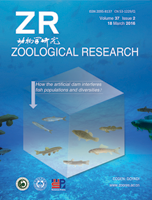
|
Zoological Research
Kunming Institute of Zoology, Chinese Academy of Sciences
ISSN: 2095-8137
Vol. 39, No. 6, 2018, pp. 413-423
|
 Bioline Code: zr18040
Bioline Code: zr18040
Full paper language: English
Document type: Research Article
Document available free of charge
|
|
|
Zoological Research, Vol. 39, No. 6, 2018, pp. 413-423
| en |
Tail regeneration reduction in lizards after repetitive amputation or cauterization reflects an increase of immune cells in blastemas
Alibardi, Lorenzo
Abstract
Lizards are key amniote models for studying organ regeneration. During tail regeneration in lizards, blastemas contain sparse granulocytes, macrophages, and lymphocytes among the prevalent mesenchymal cells. Using transmission electron microscopy to examine scarring blastemas after third and fourth sequential tail amputations, the number of granulocytes, macrophages, and lymphocytes increased at 3–4 weeks in comparison to the first regeneration. An increase in granulocytes and agranulocytes also occurred within a week after blastema cauterization during the process of scarring. Blood at the third and fourth regeneration also showed a significant increase in white blood cells compared with that under normal conditions and at the first regeneration. The extracellular matrix of the scarring blastema, especially after cauterization, was denser than that in the normal blastema and numerous white blood cells and fibroblasts were surrounded by electron-pale, fine fibrinoid material mixed with variable collagen fibrils. In addition to previous studies, the present observations support the hypothesis that an increase in inflammation and immune reactions determine scarring rather than regeneration. These new findings verify that an immune reaction against mesenchymal and epidermal cells of the regenerative blastema is one of the main causes for the failure of organ regeneration in amniotes.
Keywords
Lizard; Tail; Repetitive regeneration; Blood; Immune cells; Ultrastructure
|
| |
© Copyright 2016 - Editorial Office of ZOOLOGICAL RESEARCH
Alternative site location: http://www.zoores.ac.cn/
|
|
